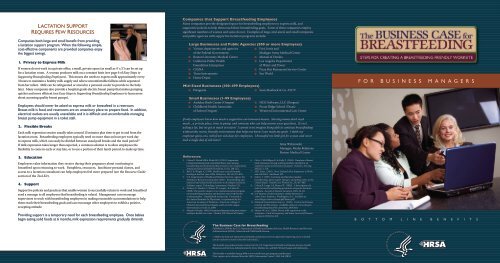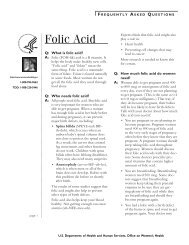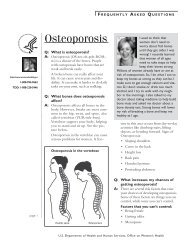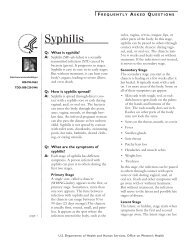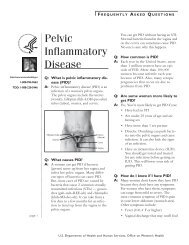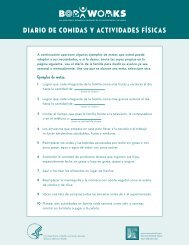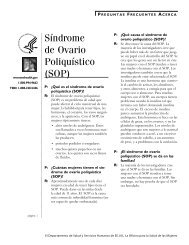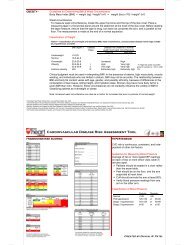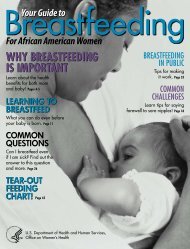The business case for breastfeeding for business managers
The business case for breastfeeding for business managers
The business case for breastfeeding for business managers
Create successful ePaper yourself
Turn your PDF publications into a flip-book with our unique Google optimized e-Paper software.
Lactation Support<br />
requireS Few reSourceS<br />
Companies both large and small benefit from providing<br />
a lactation support program. When the following simple,<br />
cost-effective components are provided companies enjoy<br />
the biggest savings.<br />
1. Privacy to Express Milk<br />
If women do not work in a private office, a small, private space (as small as 4’ x 5’) can be set up<br />
<strong>for</strong> a lactation room. A woman produces milk on a constant basis (see page 6 of Easy Steps to<br />
Supporting Breastfeeding Employees). This means she needs to express milk approximately every<br />
3 hours to maintain a healthy milk supply and relieve uncom<strong>for</strong>table fullness while separated<br />
from her infant. Milk can be refrigerated or stored in a personal cooler to provide to the baby<br />
later. Many companies also provide a hospital-grade electric breast pump that makes pumping<br />
quicker and more efficient (see Easy Steps to Supporting Breastfeeding Employees to learn more<br />
about accessing quality breast pumps).<br />
Employees should never be asked to express milk or breastfeed in a restroom.<br />
Breast milk is food, and restrooms are an unsanitary place to prepare food. In addition,<br />
electrical outlets are usually unavailable and it is difficult and uncom<strong>for</strong>table managing<br />
breast pump equipment in a toilet stall.<br />
2. Flexible Breaks<br />
Each milk expression session usually takes around 15 minutes plus time to get to and from the<br />
lactation room. Breastfeeding employees typically need no more than an hour per work day<br />
to express milk, which can easily be divided between usual paid breaks and the meal period. 12<br />
If milk expression takes longer than expected, a common solution is to allow employees the<br />
flexibility to come in early or stay late, or to use a portion of their lunch period, to make up time.<br />
3. Education<br />
Employees value in<strong>for</strong>mation they receive during their pregnancy about continuing to<br />
breastfeed upon returning to work. Pamphlets, resources, lunchtime prenatal classes, and<br />
access to a lactation consultant can help employees feel more prepared (see the Resource Guide<br />
section of the Tool Kit).<br />
4. Support<br />
Supportive policies and practices that enable women to successfully return to work and breastfeed<br />
send a message to all employees that <strong>breastfeeding</strong> is valued. Management can encourage<br />
supervisors to work with <strong>breastfeeding</strong> employees in making reasonable accommodations to help<br />
them reach their <strong>breastfeeding</strong> goals and can encourage other employees to exhibit a positive,<br />
accepting attitude.<br />
Providing support is a temporary need <strong>for</strong> each <strong>breastfeeding</strong> employee. Once babies<br />
begin eating solid foods at 6 months, milk expression requirements gradually diminish.<br />
Companies that Support Breastfeeding Employees<br />
Many companies provide designated space <strong>for</strong> <strong>breastfeeding</strong> employees to express milk, and<br />
supportive policies to help them reach their <strong>breastfeeding</strong> goals. Some of these companies employ<br />
significant numbers of women and some do not. Examples of large, mid-sized, and small companies<br />
and public agencies with supportive lactation programs include:<br />
Large Businesses and Public Agencies (500 or more Employees)<br />
■ Various departments and agencies ■ Fort Lewis and<br />
of the Federal Government Madigan Army Medical Center<br />
■ Boston University Medical Center ■ Mutual of Omaha<br />
■ Cali<strong>for</strong>nia Public Health ■ Los Angeles Department<br />
Foundation Enterprises of Water and Power<br />
■ CIGNA ■ Pizza Hut Restaurant Service Center<br />
■ Texas Instruments ■ Sea World<br />
■ Home Depot<br />
Mid-Sized Businesses (100-499 Employees)<br />
■ Patagonia ■ Sears Roebuck & Co. #2179<br />
Small Businesses (1-99 Employees)<br />
■ Andaluz Birth Center (Oregon) ■ HCG Software, LLC (Oregon)<br />
■ Childhood Health Associates ■ Pecan Ridge School (Texas)<br />
of Salem (Oregon) ■ Western Environmental Law Center<br />
If only employers knew how much a supportive environment means. Nursing moms don’t need<br />
much…a private place, time to pump, and someone who can help answer your questions. It’s not<br />
asking a lot, but we get so much in return! I cannot even imagine being able to continue <strong>breastfeeding</strong><br />
without this warm, friendly environment that helps me know I can reach my goals. I think my<br />
employer gains, too, with fewer sick days <strong>for</strong> employees. I breastfed my little girl <strong>for</strong> a year, and never<br />
took a single day of sick leave!<br />
Gina Wilczewski<br />
Manager, Media Relations<br />
Boston Medical Center<br />
References:<br />
1. Cohen R, Mrtek MB & Mrtek RG. (1995). Comparison 6. Ortiz, J, McGilligan K, & Kelly P. (2004). Duration of breast<br />
of maternal absenteeism and infant illness rates among<br />
milk expression among working mothers enrolled in an<br />
<strong>breastfeeding</strong> and <strong>for</strong>mula-feeding women in two corporations. employer-sponsored lactation program. Pediatric Nursing,<br />
American Journal of Health Promotion, 10 (2), 148-153. 30(2):111-119.<br />
2. Ball T & Wright A. (1999). Health care costs of <strong>for</strong>mula- 7. EEO Trust. (2001). New Zealand’s Best Employers in Work<br />
feeding in the first year of life. Pediatrics, 103 (4), 871-876.<br />
and Life 2001. Auckland, NZ.<br />
3. U.S. Department of Health and Human Services, Agency <strong>for</strong> 8. Galtry J. (1997). Lactation and the labor market:<br />
Healthcare Research and Quality (2007). Breastfeeding and <strong>breastfeeding</strong>, labor market changes, and public policy in the<br />
maternal and infant health outcomes in developed countries. United States. Health Care Women Int., 18, 467-480.<br />
Evidence report, Technology Assessment, Number 153. 9. Cohen R, Lange L & Slusser W. (2002). A description of a<br />
4. Dickson V, Hawkes C, Slusser W, Lange L, & Cohen R. male-focused <strong>breastfeeding</strong> promotion corporate lactation<br />
(2000). <strong>The</strong> positive impact of a corporate lactation program program. Journal of Human Lactation, 18(1), 61-65.<br />
on <strong>breastfeeding</strong> initiation and duration rates: help <strong>for</strong> the 10. U.S. Bureau of Labor Statistics. (2005) Division of<br />
working mother. Unpublished manuscript. Presented at<br />
Labor Force Statistics, Washington, D.C. Available at:<br />
the Annual Seminar <strong>for</strong> Physicians, co-sponsored by the<br />
www.bls.gov/news.release/pdf/famee.pdf<br />
American Academy of Pediatrics, American College of<br />
11. National Immunization Survey. (2005). Centers <strong>for</strong> Disease<br />
Obstetricians and Gynecologists, and La Leche League<br />
Control and Prevention. Available online at: www.cdc.gov/<br />
International, on July 21, 2000.<br />
<strong>breastfeeding</strong>/data/NIS_data/data_2005.htm<br />
5. M utual of Omaha. (2001). Prenatal and lactation education reduces 12. Slusser W. et al. (2004). Breast milk expression in the<br />
newborn health care costs. Omaha, NE: Mutual of Omaha. workplace: a look at frequency and times. Journal of Human<br />
Lactation 20(2):164-169.<br />
<strong>The</strong> Business Case <strong>for</strong> Breastfeeding<br />
Published in 2008 by the U.S. Department of Health and Human Services, Health Resources and Services<br />
Administration (HRSA), Maternal and Child Health Bureau.<br />
“...HRSA, the lead U.S. Department of Health and Human Services Agency <strong>for</strong> improving access to health<br />
care <strong>for</strong> underserved and vulnerable individuals..” .<br />
This booklet was produced under contract <strong>for</strong> the U.S. Department of Health and Human Services, Health<br />
Resources and Services Administration by Every Mother, Inc. and Rich Winter Design and Multimedia.<br />
This booklet is available during 2008 at www.mchb.hrsa.gov/pregnancyandbeyond<br />
Print copies can be obtained from the HRSA In<strong>for</strong>mation Center 1-888-Ask-HRSA<br />
For Business Managers<br />
B o t t o M L i n e B e n e F i t s
<strong>The</strong> BuSineSS caSe For<br />
BreaStFeeding<br />
Companies successful at retaining valued employees after childbirth<br />
find that two components can make the difference: providing<br />
dedicated space (as small as 4’ x 5’) <strong>for</strong> <strong>breastfeeding</strong> employees to<br />
express milk in privacy, and providing worksite lactation support.<br />
<strong>The</strong> payoff is significant: more satisfied, loyal employees and cost<br />
savings to the <strong>business</strong>. <strong>The</strong>se savings are seen in such areas as:<br />
■■<br />
■<br />
■<br />
Retention of experienced employees;<br />
Reduction in sick time taken by both moms and dads <strong>for</strong> children’s illnesses; and<br />
Lower health care and insurance costs.<br />
This booklet provides <strong>business</strong> executives and <strong>managers</strong>, as well as human resource <strong>managers</strong>, with<br />
the <strong>business</strong> <strong>case</strong> <strong>for</strong> <strong>breastfeeding</strong>…how supporting <strong>breastfeeding</strong> employees contributes to their<br />
0<br />
company’s return on investment (ROI).<br />
■ ■ ■<br />
the return on inveStment<br />
Supporting your <strong>breastfeeding</strong> employees saves money. Here’s how.<br />
1. Breastfeeding employees miss work less often<br />
That’s because breastfed infants are healthier! Human milk boosts an infant’s immune system and<br />
0 20 0<br />
helps protect him from common childhood illnesses, infections, and dermatitis. For infants in<br />
childcare 0 settings where they are exposed to a multitude of germs and viruses, human milk provides<br />
even greater protection. Mothers and fathers of breastfed infants typically spend more time at work<br />
rather than taking leave to care <strong>for</strong> sick children.<br />
Business Savings<br />
■ One-day absences to care <strong>for</strong> sick children occur more than twice as often <strong>for</strong> mothers of<br />
<strong>for</strong>mula feeding infants. 1<br />
Mothers of 25%<br />
Breastfed Infants<br />
Percentage of Infant Illnesses<br />
Requiring 1-Day Maternal Absence from Work 1<br />
Mothers of Formula Fed Infants<br />
75%<br />
2. Breastfeeding lowers health care costs<br />
<strong>The</strong> reduced health care costs <strong>for</strong> breastfed infants translate into lower<br />
medical insurance claims <strong>for</strong> <strong>business</strong>es. Babies who are not breastfed<br />
visit the physician more often, spend more days in the hospital, and<br />
require more prescriptions than breastfed infants. One study found that<br />
<strong>for</strong> every 1,000 babies not breastfed, there were 2,033 extra physician<br />
visits, 212 extra hospitalization days, and 609 extra prescriptions <strong>for</strong> three<br />
illnesses alone – ear, respiratory, and gastrointestinal infection. 2 This does<br />
not include the risks of numerous other childhood illnesses and infections,<br />
or women’s diseases such as pre-menopausal breast cancer, which are reduced when a mother breastfeeds. 3<br />
Business Savings<br />
■ <strong>The</strong> insurance company CIGNA conducted a 2-year study of 343 employees who<br />
participated in their lactation support program, and found that the program resulted in<br />
an annual savings of $240,000 in health care expenses, 62 percent fewer prescriptions, and<br />
$60,000 savings in reduced absenteeism rates. 4<br />
3. Investing in a worksite lactation support program<br />
can yield substantial dividends to the company<br />
Companies of all types have found that implementing a lactation support program can have a<br />
positive impact on their bottom line. Just a few of these important dividends include lower turnover<br />
rates, additional health care savings, higher productivity and loyalty, and positive public relations.<br />
Lower Turnover Rates<br />
Employees are more likely to return to work after childbirth when their workplace provides a<br />
supportive environment <strong>for</strong> continued <strong>breastfeeding</strong>. Being able to keep experienced employees<br />
after childbirth means lowering or eliminating the costs a company otherwise would incur to hire<br />
temporary staff or to recruit, hire, and train replacement staff, both of which involve additional lost<br />
revenue while getting these new staff up to speed.<br />
Business Savings<br />
■ Mutual of Omaha’s lactation support program led to a retention rate of 83 percent of their<br />
maternity work<strong>for</strong>ce compared to the national average of only 59 percent. 5<br />
■ Another study of several companies with lactation programs showed a retention rate of 94.2 percent. 6<br />
■ A New Zealand study estimated $75,000 in savings <strong>for</strong> each employee who returns to work<br />
after maternity leave. 7<br />
Retention Rate <strong>for</strong> Employees<br />
of Companies with Lactation Support Programs<br />
Companies with Lactation Support Programs 94.2%<br />
National Average 59%<br />
Additional Health Care Savings<br />
Companies that provide comprehensive onsite lactation support<br />
programs enjoy additional health care cost savings. That’s because<br />
these programs encourage employees to breastfeed longer and to<br />
breastfeed exclusively to 6 months (the recommendation of the<br />
American Academy of Pediatrics) which provides the greatest<br />
health advantages <strong>for</strong> <strong>breastfeeding</strong> employees and their infants.<br />
When programs include prenatal education to help improve birth<br />
outcomes, the savings are even greater.<br />
Business Savings<br />
■ Mutual of Omaha found that health care costs <strong>for</strong> newborns are three times lower <strong>for</strong><br />
babies whose mothers participate in their company’s maternity and lactation program.<br />
Per person health care costs were $2,146 more <strong>for</strong> employees who did not participate in<br />
the program, with a yearly savings of $115,881 in health care claims <strong>for</strong> the <strong>breastfeeding</strong><br />
mothers and babies. 4<br />
Higher Productivity and Loyalty<br />
Employees whose companies provide <strong>breastfeeding</strong> support consistently report improved morale,<br />
better satisfaction with their jobs, and higher productivity. 8 <strong>The</strong>y also feel the support eases their<br />
transition back to work and enables them to return from maternity leave sooner.<br />
Business Savings<br />
Although 80 percent of its employees are male, the Los Angeles Department of Water and<br />
Power found that a lactation support program <strong>for</strong> mothers, fathers, and partners of male<br />
employees made a dramatic difference in reducing turnover and absenteeism rates <strong>for</strong><br />
both male and female workers. <strong>The</strong>y also found that 83 percent of employees were more<br />
positive about the company as a result of the program, and 67 percent intended to make it<br />
their long-term employer. 9<br />
■■<br />
Positive Public Relations<br />
Providing a supportive environment <strong>for</strong> <strong>breastfeeding</strong> employees improves your overall company<br />
image and enhances your ability to recruit top-notch staff. Many companies with support<br />
programs receive local, state, and national recognition and media attention, a positive boost to<br />
recruitment ef<strong>for</strong>ts and general goodwill in the community.<br />
Profits and People<br />
Today, women with children are the fastest growing segment of the work<strong>for</strong>ce.<br />
Nearly 55 percent of women with children under the age of 3 are employed. 10 In the<br />
United States, more than 70 percent of all new mothers today choose to breastfeed to<br />
give their babies important nutrition and health benefits. 11 Family-friendly policies<br />
and programs that provide lactation support <strong>for</strong> both female employees and partners<br />
of male employees enhance your employee health benefits package and help protect<br />
your company’s investment in staff through better retention of valued employees.<br />
0% 10% 20% 30% 40% 50%<br />
60% 70% 80% 90% 100%<br />
0% 10% 20% 30% 40% 50% 60% 70% 80% 90% 100%


